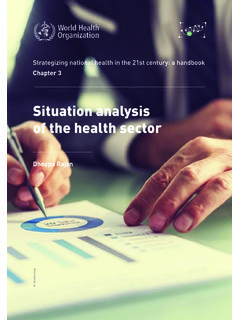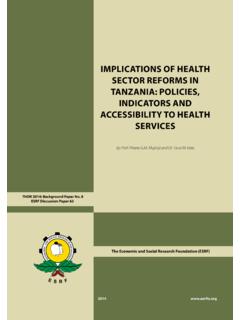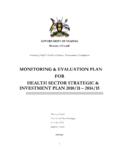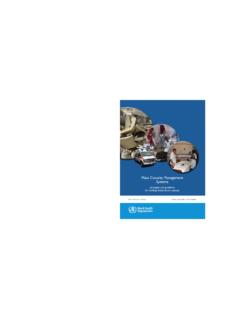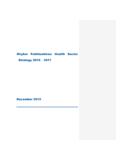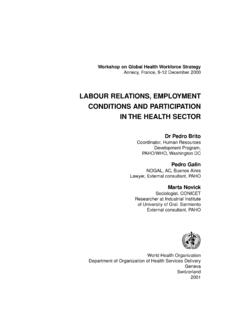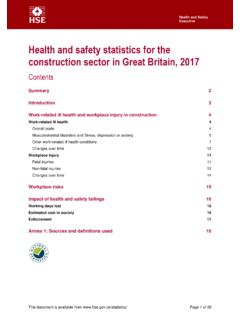Transcription of Health and safety in the Manufacturing sector in …
1 This document is available from Page 1 of 22 Health and safety Executive Health and safety in the Manufacturing sector in Great Britain, 2017 Contents Summary 2 Introduction 3 Work-related illness and workplace injury in the Manufacturing sector 4 Work-related illness 4 All work-related illness 4 Musculoskeletal Disorders 6 Stress 7 Occupational lung disease 8 Skin Disease 8 Occupational Cancer 9 Changes over time 10 Workplace Injury 11 Fatal injuries 11 Non-fatal injuries 12 Changes over time 15 Workplace risks 17 Impacts of Health and safety failings. 18 Working days lost 18 Economic cost 18 Enforcement 19 Annex 1: Sources and definitions used 20 Annex 2: Links to detailed tables 21 This document is available from Page 2 of 22 Summary The document can be found at: Health and safety in the Manufacturing sector in Great Britain 80,000 workers suffering from a work-related illness each year (LFS) 19 fatal injuries to workers in 2016/17 60,000 non-fatal injuries to workers each year (LFS) Work-related ill Health by illness type (Source: LFS annual average estimate 2014/15-2016/17) Fatal injuries to workers by most common accident kinds (Source: Fatal injuries reportable under RIDDOR, 2012/13-2016/17 Non-fatal injuries to employees by most common accident kinds (Source.))
2 Non-fatal injuries reported under RIDDOR 2014/15-2016/17) Note: LFS: Labour Force Survey (annual average estimates in 2014/15-2016/17). Illness estimates include both new and longstanding cases RIDDOR: Reporting of Injuries Diseases and Dangerous Occurrences Regulations The most common accident kinds included in the charts above are those that account for 10% or more of injuries This document is available from Page 3 of 22 Introduction This report provides a profile of workplace Health and safety in the Manufacturing1 sector . Broadly speaking Manufacturing includes activities that involve the physical or chemical transformation of materials, substances or components into new products. Outputs may be finished products (ready for use) or semi-finished in the sense that it is to become an input for further Manufacturing .
3 The 2007 Standard Industrial Classification (SIC) divides Manufacturing into 24 divisions. For the purpose of this report, to ensure reliable statistical estimates, these 24 divisions have been grouped into 6 broad sub-sectors, namely: Manufacture of food and drink products (SIC 10 and 11). Manufacture of non-metallic products (SIC 16,17,22,23,31), covering manufacture of: wooden products; pulp paper and converted paper products; rubber and plastic products; other non-metallic products such as glass, ceramics, brick, cement and plaster; furniture. Manufacture of chemical and pharmaceutical products (SIC 19-21), covering manufacture of : coke and refined petroleum products ( petrol refinery); manufacture of chemicals and chemical products, which includes the transformation of organic and inorganic raw materials by a chemical process; basic pharmaceutical products and preparations.
4 Manufacture of metallic products (SIC 24,25) covering the manufacture of basic metals and fabricated metal products (except machinery and equipment). Manufacture of transport and transport products (SIC 29,30), covering manufacture of motor vehicles, trailers and other transport equipment such as ships, boats, rail locomotives and rolling stock, air and spacecrafts. Other Manufacturing (SIC 12-15,18,26-28,32-33) including manufacture of: Textiles, wearing apparels and leather and related products; Tobacco products; Printing and reproduction of recorded media; Computer, electronic and optical products, electrical equipment and other machinery and equipment; Repair and installation of machinery and equipment and other Manufacturing . The Manufacturing sector is a major employer accounting for around 9% of the UK workforce2.
5 This report considers the current Health and safety situation in the sector . 1 The Manufacturing sector is defined by section C within the 2007 Standard Industrial Classification. See for more details 2 Annual Population Survey 2016 This document is available from Page 4 of 22 Work-related illness and workplace injury in the Manufacturing sector Work-related illness All work-related illness Figure 1: Estimated annual number of cases of self-reported work-related illness in the Manufacturing sector Source: Labour Force Survey (LFS), annual average 2014/15-2016/17 Between 2014/15 and 2016/17: Annually, around 80,000 Manufacturing workers in GB were suffering from an illness they believe was caused or made worse by their work.
6 Around 40% of these cases were new conditions which started during the year, while the remainder were long-standing conditions. Of the estimated 80,000 annual cases: 43% (34,000 cases) were musculoskeletal disorders (MSD), of which around a third were new conditions; 28% (23,000 cases) were stress, depression or anxiety cases, of which about half were new conditions; 29% (23,000 cases) were other illness conditions (such as skin or respiratory conditions), of which around half were new conditions. Figure 2: Estimated rate of all self-reported work-related illness (per 100,000 workers) in the Manufacturing sector Source: LFS, annual average 2014/15-2016/17 Expressing the total number of work-related illness cases as a rate: Annually between 2014/15 and 2016/17 around of workers in the Manufacturing sector in GB were suffering from an illness that they believe was caused or made worse by their work in the sector .
7 This rate is statistically significantly lower than the rate for workers across all industries ( ). This document is available from Page 5 of 22 Figure 3: Estimated annual cases of self-reported work-related illness by sub- sector Source: LFS annual average 2011/12, 2013/14-2016/17 Manufacturing covers a diverse range of sectors, from heavy traditional Manufacturing industries, such as ship building through to precision engineering such as manufacture of optical products. Figure 3 opposite looks at data from the Labour Force Survey from the last five years3 and shows the spread of work-related ill Health cases across the different sub-sectors within Manufacturing . While it is interesting to see the spread of work-related ill Health across the sub-sectors within Manufacturing , it will be heavily influenced by variations in the number of people employed in these sub-sectors.
8 To make comparisons between different industry groups we generally consider the rate of work-related ill Health rather than the number of cases, as the rate accounts for variations in the number of people in work between different groups. Figure 4: Estimated rate of all self-reported work-related illness (per 100,000 workers) in the sub-sectors within Manufacturing Source: LFS annual average 2011/12, 2013/14-2016/17 While the rate of work-related ill Health in food and drink manufacture appears higher than the average rate across all industries ( compared with ), the difference is not statistically significant ( the difference may be due to sampling error that results from surveying a sample of workers rather than the full population). Conversely, while the rate of work-related ill Health in chemical and pharmaceutical Manufacturing appears lower than the average across all industries ( compared with ) the difference is not statistically significant.
9 Similarly there is no significant difference between the rate in non-metallic product Manufacturing and the average across all industries. In contrast, transport and transport product manufacture, metallic product manufacture and other Manufacturing all have rates of work-related ill Health that are statistically significantly lower than the average across all industries 3 Estimates for the more detailed industry groups in Manufacturing have been based on the five year period 2011/12, 2013/14-2016/17. This is in order to improve the reliability of the estimates and thus be able to better draw out any inferences on performance of Health and safety in these sectors compared to the average across all industries.
10 Since estimates are based on a slightly different time period than they may differ slightly to estimates based on the three year period 2014/15-2016/17. This document is available from Page 6 of 22 On average, stress and musculoskeletal disorders account for around 70% of the work-related illness cases in the Manufacturing sector (Source: Labour Force Survey 2014/15-2016/17). Looking at how the Manufacturing sector compares to all industries for these two illness types: Musculoskeletal Disorders Figure 5: Estimated rate of all self-reported work-related musculoskeletal disorders (per 100,000 workers) in the Manufacturing sector Source: LFS, annual average 2014/15-2016/17 Expressing the total number of musculoskeletal disorder cases in the Manufacturing sector as a rate: Annually around of workers in the sector were suffering from a musculoskeletal disorder they believed was work-related.










